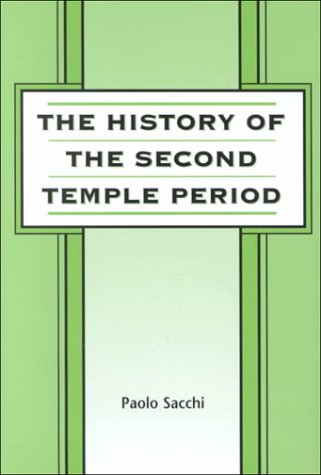The History of the Second Temple Period
Written by Paolo Sacchi Reviewed By Brian KellyThe title of this work may be initially misleading. Older, conventional histories of the biblical period focus upon narrating the events and personages of the time (often with greater emphasis on the pre-exilic period). This work, by a distinguished Italian specialist in Second Temple Judaism, gives due space to events and people, but concentrates more on the ideologies or religious themes and currents of the post-exilic era, and the sects or parties representing these beliefs. This approach is informed by the newer critical consensus that much of the OT received its final form only during the Persian and Hellenistic periods, a contention which holds for the ideologies as well. The author’s aim is to place in context certain aspects of pre-Christian Jewish thought (the ‘Middle Judaism’ of c. 200 BCE onwards) as a prelude to a better understanding of earliest Christianity.
Sacchi sees Hebrew and Jewish thought oriented toward ‘the search for salvation’ (33), a concept which is refined over the centuries from salvation of the people to that of the individual, and finally to ‘otherworldly salvation’, belief in life after death. The means of achieving salvation can be grouped together in two fundamental categories for conceiving religion, which are conveniently termed ‘the Theology of the Promise’ and ‘the Theology of the Covenant’. These terms refer not to separate theological systems but to ‘two underlying attitudes of the Hebrew soul’ (37). According to the first category, Israel’s existence and survival are guaranteed by God’s gracious promise, human guilt notwithstanding. ‘Messianic’ thinking (in all its forms) has its roots within this basic concept. ‘The Theology of the Covenant’, on the other hand, focuses upon human freedom and Israel’s responsibility to keep the Law. This outlook is seen as gaining increasing importance in what was to become canonical Judaism. It is linked with a converging understanding, towards the end of the Persian period, of sacrality and purity, and the growing power of the priesthood in an age without kings. From 200 BCE on to 70 CE, these two positions and the sects representing them (Pharisees, Sadducees, Essenes and Samaritans) became more sharply divided, and ‘a deep spiritual crisis’ (305) characterised that period. Here the author’s great expertise in the extra-canonical literature (Qumran, Apocrypha, Enochic writings, and Pseudepigrapha) comes strongly into play.
The book is organised according to four major sections: The Age of Exile; The Zadokite Period (c. 520–200 BCE); From the Seleucid Domination to 70 CE; and Themes of Middle Judaism. The reconstruction of events, and the dating and interpretation of individual texts are generally in line with the standard critical consensus, although Sacchi occasionally ploughs his own furrow, for example, with some controversial contentions about events of the early post-exilic period (64–67). The last section, drawing on a diverse range of literature, is probably the most accessible to most readers. Here is a succinct discussion of such themes as religious knowledge and revelation; predestination, dualism and evil; salvation, purification and life beyond death; and forms of messianism. The reverberation of these themes in the NT is clear, but the last chapter of the book, ‘Jesus in his Time’, is too brief (and Ritschlian in tone) to serve as the capstone of this work.
There are of course many points where readers of more conservative conviction would take issue with the author, over the dating and interpretation of texts, or over the rise of messianism or the question of theodicy. However, this is a work of synthesis rather than exposition, and this book, marked by great erudition and subtlety of argument, should serve as a point of reference, even when we will want to disagree.
Brian Kelly
Canterbury







